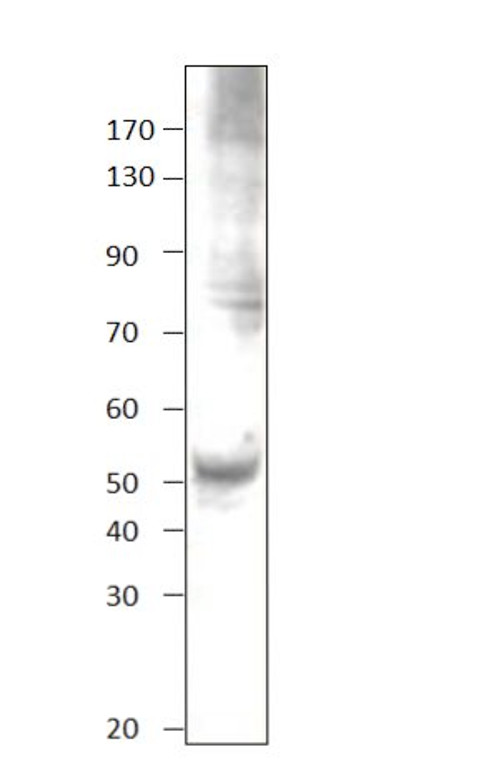| Host: |
Rabbit |
| Applications: |
ELISA/IP/WB |
| Reactivity: |
Human/Mouse/Rat |
| Note: |
STRICTLY FOR FURTHER SCIENTIFIC RESEARCH USE ONLY (RUO). MUST NOT TO BE USED IN DIAGNOSTIC OR THERAPEUTIC APPLICATIONS. |
| Short Description: |
Rabbit polyclonal antibody anti-RUNX3 (1-50) is suitable for use in ELISA, Immunoprecipitation and Western Blot research applications. |
| Clonality: |
Polyclonal |
| Conjugation: |
Unconjugated |
| Isotype: |
IgG |
| Purification: |
Affinity Purified |
| Concentration: |
0.52-0.53 µg/µl |
| Dilution Range: |
WB: 1:500DB: 1:10, 000ELISA: 1:10, 000IP: 1:150 |
| Storage Instruction: |
Store at-20°C for long term storage. Avoid freeze-thaw cycles. |
| Gene Symbol: |
RUNX3 |
| Gene ID: |
864 |
| Uniprot ID: |
RUNX3_HUMAN |
| Immunogen Region: |
1-50 |
| Immunogen: |
Synthetic peptide taken within amino acid region 1-50 on human Runt-related transcription factor 3 protein. |
| Tissue Specificity | Expressed in gastric cancer tissues (at protein level). |
| Post Translational Modifications | Phosphorylated on tyrosine residues by SRC. Phosphorylated by LCK and FYN. |
| Function | Forms the heterodimeric complex core-binding factor (CBF) with CBFB. RUNX members modulate the transcription of their target genes through recognizing the core consensus binding sequence 5'-TGTGGT-3', or very rarely, 5'-TGCGGT-3', within their regulatory regions via their runt domain, while CBFB is a non-DNA-binding regulatory subunit that allosterically enhances the sequence-specific DNA-binding capacity of RUNX. The heterodimers bind to the core site of a number of enhancers and promoters, including murine leukemia virus, polyomavirus enhancer, T-cell receptor enhancers, LCK, IL3 and GM-CSF promoters. May be involved in the control of cellular proliferation and/or differentiation. In association with ZFHX3, up-regulates CDKN1A promoter activity following TGF-beta stimulation. CBF complexes repress ZBTB7B transcription factor during cytotoxic (CD8+) T cell development. They bind to RUNX-binding sequence within the ZBTB7B locus acting as transcriptional silencer and allowing for cytotoxic T cell differentiation. CBF complexes binding to the transcriptional silencer is essential for recruitment of nuclear protein complexes that catalyze epigenetic modifications to establish epigenetic ZBTB7B silencing. |
| Protein Name | Runt-Related Transcription Factor 3Acute Myeloid Leukemia 2 ProteinCore-Binding Factor Subunit Alpha-3Cbf-Alpha-3Oncogene Aml-2Polyomavirus Enhancer-Binding Protein 2 Alpha C SubunitPea2-Alpha CPebp2-Alpha CSl3-3 Enhancer Factor 1 Alpha C SubunitSl3/Akv Core-Binding Factor Alpha C Subunit |
| Database Links | Reactome: R-HSA-4411364Reactome: R-HSA-8941855Reactome: R-HSA-8941856Reactome: R-HSA-8941858Reactome: R-HSA-8949275Reactome: R-HSA-8951430Reactome: R-HSA-8951671Reactome: R-HSA-8951911Reactome: R-HSA-8951936Reactome: R-HSA-8952158 |
| Cellular Localisation | NucleusCytoplasmThe Tyrosine Phosphorylated Form Localizes To The CytoplasmTranslocates From The Cytoplasm To The Nucleus Following Tgf-Beta Stimulation |
| Alternative Antibody Names | Anti-Runt-Related Transcription Factor 3 antibodyAnti-Acute Myeloid Leukemia 2 Protein antibodyAnti-Core-Binding Factor Subunit Alpha-3 antibodyAnti-Cbf-Alpha-3 antibodyAnti-Oncogene Aml-2 antibodyAnti-Polyomavirus Enhancer-Binding Protein 2 Alpha C Subunit antibodyAnti-Pea2-Alpha C antibodyAnti-Pebp2-Alpha C antibodyAnti-Sl3-3 Enhancer Factor 1 Alpha C Subunit antibodyAnti-Sl3/Akv Core-Binding Factor Alpha C Subunit antibodyAnti-RUNX3 antibodyAnti-AML2 antibodyAnti-CBFA3 antibodyAnti-PEBP2A3 antibody |
Information sourced from Uniprot.org
12 months for antibodies. 6 months for ELISA Kits. Please see website T&Cs for further guidance





